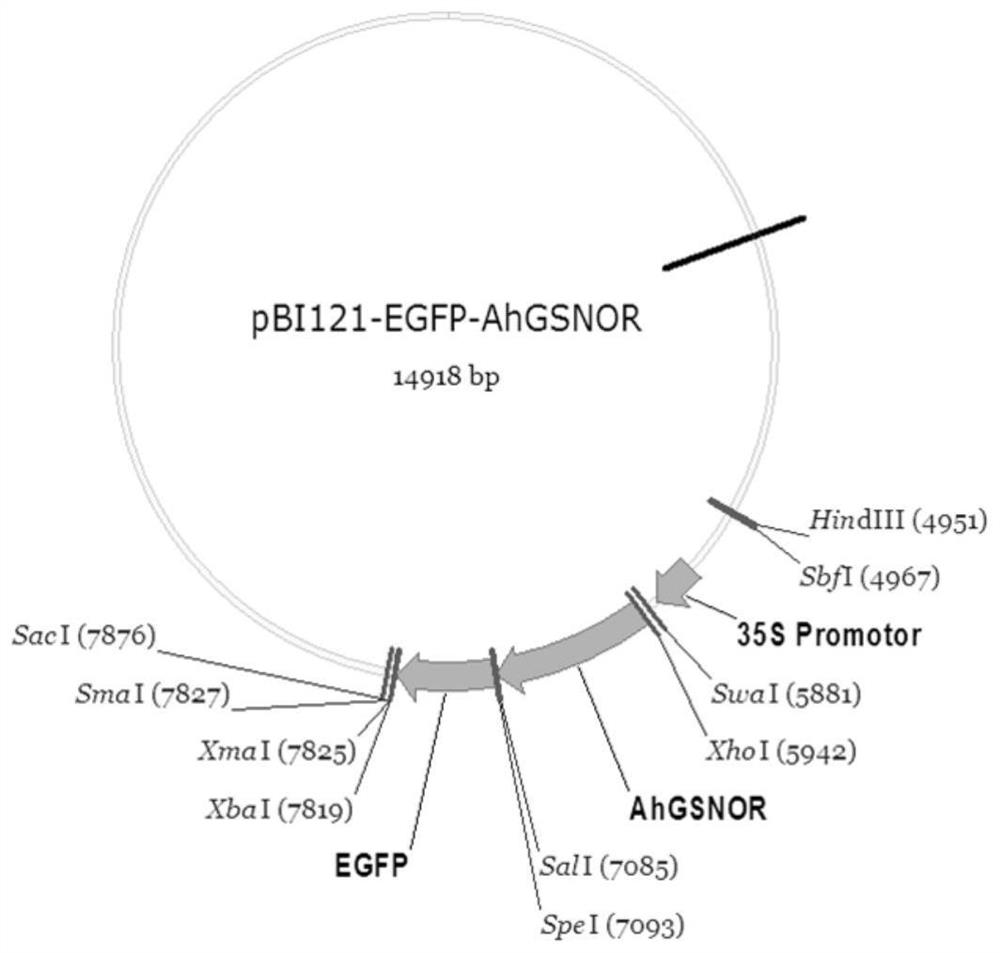Method for Improving Aluminum Tolerance of Plants Using Peanut ahgsnor Gene
A gene and peanut technology, which is applied in the field of peanut AhGSNOR gene to improve the aluminum tolerance of plants, can solve the problems such as no aluminum tolerance has been found, and achieve the effect of improving tolerance
- Summary
- Abstract
- Description
- Claims
- Application Information
AI Technical Summary
Problems solved by technology
Method used
Image
Examples
Embodiment 1
[0043] Acquisition of the DNA fragment of the AhGSNOR gene. The specific steps are as follows: take 0.2 g of peanut root tips, and use Trizol reagent (Invitrogen) to extract total RNA. RNA was reverse transcribed into cDNA using the RevertAid(TM) first Strand cDNA Synthesis Kit (ThermoScientific). According to the peanut AhGSNOR gene sequence (SEQ ID NO: 1), an upstream primer (5'- CTCGAG ATGGCAACTCAAGGTCAAGT-3', where the underline is the Xho I site) and the downstream primer (5' GTC GAC TGCATCTGTTGAAAGAACAC-3', wherein the underline is the Sal I site), and the peanut cDNA was used as a template for PCR amplification. The PCR reaction conditions were: pre-denaturation at 95°C for 2 min; denaturation at 95°C for 30 s, annealing at 58°C for 30 s, extension at 72°C for 90 s, and 35 cycles. The PCR product was gel-recovered using a DNA purification and recovery kit (Tiangen), the recovered product was ligated to the pMD19-T vector, positive clones were screened and sequenced...
Embodiment 2
[0045]The overexpression vector of AhGSNOR gene was constructed. The specific steps are as follows: extract the pMD-AhGSNOR positive cloning plasmid and the pBI121-EGFP carrier plasmid in Example 1 (the carrier can be obtained through open and commercially available commercial channels), and use restriction enzymes XhoI and Sal I to carry out double enzymes respectively. Cut, and use the DNA purification and recovery kit (Tiangen) to recover the digested fragments. The digested fragments were ligated with a DNA ligation kit (Takara). The ligation reaction system was 4 μL of the product recovered from pMD-AhGSNOR gel and 1 μL of the product recovered from pBI121-EGFP gel. The reaction conditions were 16° C. for 3 h. The ligated product was transformed into DH5a competent cells, single colonies were screened for resistance using 100 mg / L kanamycin, and the obtained positive clones were sequenced and verified. The positive clone with correct sequencing was named as pBI121-AhGSNO...
Embodiment 3
[0047] The AhGSNOR gene was introduced into tobacco plants through the genetic transformation system mediated by Agrobacterium. Specific steps are as follows:
[0048] (1) Cultivation of sterile tobacco seedlings: Soak tobacco seeds in 75% ethanol for 1 min, then soak in 0.1% mercuric chloride for 5 min, and rinse with sterile water for 3-5 times. The sterilized seeds were inoculated onto MS basic medium with sterile tweezers, and placed in a 26°C incubator for cultivation.
[0049] (2) Acquisition of leaf discs: when the sterile seedlings induced by seeds grow to a leaf width of 1-1.5cm, the leaves are cut off and the back of the leaves are scratched, and inoculated with 1.0mg / L 6-BA and 0.2mg / L In the solid medium of L NAA, culture in the dark for 2 days.
[0050] (3) Infection: Draw 2 mL of the Agrobacterium EHA105 containing pBI121-AhGSNOR in Example 2 and inoculate it into 100 mL of YEP liquid culture containing 25 mg / L rifampicin, 25 mg / L streptomycin and 100 mg / L kana...
PUM
 Login to View More
Login to View More Abstract
Description
Claims
Application Information
 Login to View More
Login to View More - R&D
- Intellectual Property
- Life Sciences
- Materials
- Tech Scout
- Unparalleled Data Quality
- Higher Quality Content
- 60% Fewer Hallucinations
Browse by: Latest US Patents, China's latest patents, Technical Efficacy Thesaurus, Application Domain, Technology Topic, Popular Technical Reports.
© 2025 PatSnap. All rights reserved.Legal|Privacy policy|Modern Slavery Act Transparency Statement|Sitemap|About US| Contact US: help@patsnap.com



